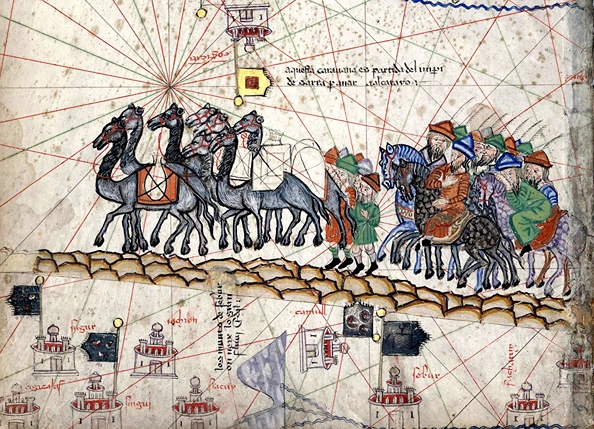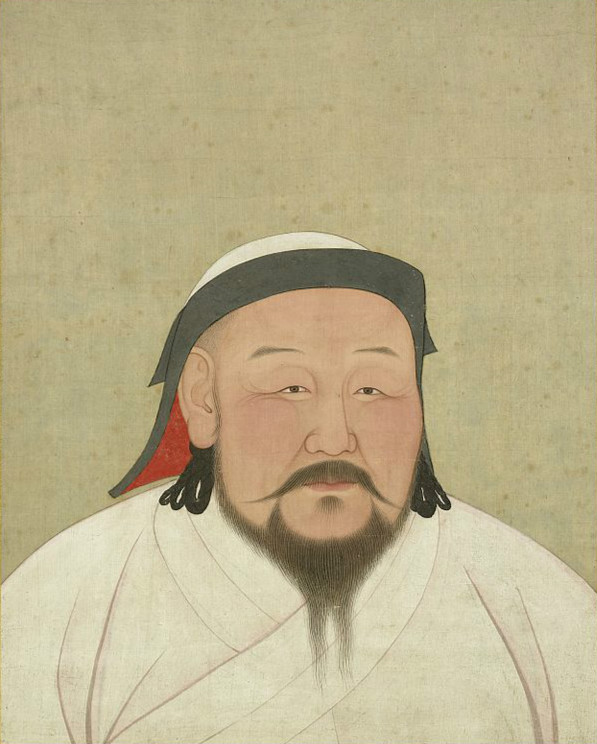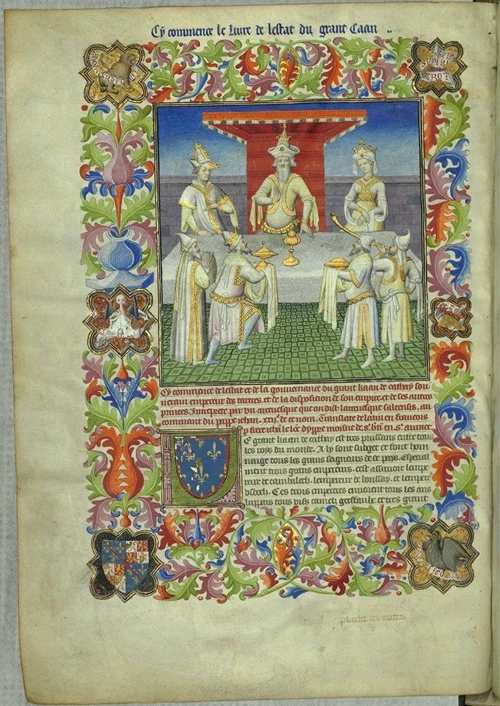
Marco Polo's caravan traveling to India, Abraham Cresques, 1375. Source: Catalan Atlas, Wikipedia Commons (public domain).
Background and Origin of Marco Polo
One of the reasons why Marco Polo was able to carry out such a long journey across the Eurasian landmass was his family's professional background. Both his father and uncle were merchants. Merchants traveled along the Silk Road between Europe and Asia at this time. The Polo family was involved in trade with the Middle East. As a result, Niccolò, the father, and Maffeo, the uncle, both had excellent professional reputations and wealth. In 1271, the three men left Venice. Venice was their home base and likely where the young Marco grew up. Venice was also one of the most successful and wealthy Italian city-states.
A city-state is a city with self-government and sovereignty in the political, social, and cultural realm. City-states were the main form of political organization in Europe during the Middle Ages and the Renaissance.
The Polos' four-year journey to China occurred in a changing global context. Constantinople was under the control of western crusaders since 1204. The Polos sold their property approximately in 1260 and invested in jewels instead. They seemed to have understood that political changes were coming. Indeed, Michael VIII Palaeologus overthrew the crusaders and established his rule in 1261.
Marco's father and uncle journeyed to the Volga River, controlled by the Mongol Empire at this time. Berke Khan ruled this part of the Empire. The two elder Polos could stay at the Khan's court, where they multiplied their wealth. However, they could not return to Venice due to the political situation.
The two Polos decided to travel in the opposite direction—eastward—and likely stopped at Xanadu (Shangdu), in present-day China. They managed to cultivate an amicable relationship with Kublai Khan, the ruler of the vast Mongol Empire. Indeed, the Khan liked the Polos so much that he sent them back to Europe, where they operated as his ambassadors.
The Travels of Marco Polo
Marco Polo, along with his father and uncle, departed from Venice when he was only 17 years old in 1271. Whereas the Polos initially traveled by boat to Persia (Iran) in the Mediterranean, most of the journey occurred over land. The Polos traveled through the Mongol Empire to China and possibly Beijing, the winter capital.
Marco Polo stayed in China at the court of Kublai Khan until approximately 1291. During his stay, he learned Chinese and held diplomatic positions traveling throughout Southeast Asia on assignments for the great Khan. His last assignment was to take a princess to Persia to marry Arghun Khan.
In 1295, Marco was back in his hometown, Venice. The total distance traveled by the Polos came close to 24,000 kilometers (15,000 miles).
Marco Polo: Biography and Timeline
1254: Marco Polo was born in Venice.
1260: Marco's father, Niccolò, and uncle, Maffeo, left their residence in Constantinople (present-day Istanbul, Turkey).
1265: Marco's father and uncle traveled east through Bukhara (Uzbekistan) and spent time at Xanadu (Shangdu), present-day China.
1269: Marco's father and uncle returned to their hometown, Venice.
1271: Marco, his father, and his uncle departed from Venice and traveled across Eurasia.
1272: The Polos passed through Erzurum (eastern Turkey) and Tabriz (northern Iran) and arrived at Hormuz (Persian Gulf).
1272-3: The Polos travel through Afghanistan, Pakistan, and possibly Kashmir. They used the Silk Road to reach China.
1274: Traveling approximately 8,000 km, the Polos arrived in China (Cathay). They met Kublai Khan in Shangdu, the summer capital, bringing with them papal letters. Marco studied the Chinese language.
1275: Marco Polo became an envoy for the great Khan. He traveled as a diplomat throughout Southeast Asia (Vietnam, India, Burma, Indonesia, and Sri Lanka). Marco may have also stayed in Beijing, Kublai Khan's winter residence.
1280: Marco Polo may have also become the governor of Yangzhou.
1291: Marco Polo headed back to Europe, accompanying princess Kököchin scheduled to marry Arghun Khan in Persia.
1293: The Polos arrived in Persia, then headed to Constantinople.
1295: Marco Polo returned to Venice.
1298: Marco Polo was imprisoned during a war between Venice and its rival, Genoa. He dictated a book about his travels in prison to another inmate, Rustichello da Pisa, who was a professional writer. The Travels of Marco Polo is a combination of fact and fiction embellished by Marco and his ghostwriter.
1299: Marco Polo left prison.
1300: Donata Badoer and Marco Polo were married.
1324: The death of Marco Polo.
The Silk Road (130 BCE-1453) comprised several trade routes used to connect Europe to Asia at this time.
Kublai Khan
Kublai Khan (1215-1294) was the ruler of the vast Mongol Empire and the grandson of Genghis Khan. Kublai Khan even conquered China and established the Yuan Dynasty. Genghis Khan initiated the invasion of China in 1211, which Kublai Khan finished in 1279. As a result, the Mongol Empire spanned the continent of Eurasia and included southern Russia and Persia (Iran).
Kublai Khan managed to unify China, divided for centuries, despite being a foreigner and a nomad. Indeed, Mongols practiced the traditional nomadic lifestyle at this time and had little experience in governing and statecraft. The difficulties of ruling China resulted in the Yuan control of that country lasting less than a hundred years.
Nomads are people who travel without having a single home base. Traditionally, the nomadic lifestyle was linked to grazing cattle or hunting cultures.

Kublai Khan, Anige of Nepal, ca. 1294. Source: Wikipedia Commons (public domain).
Impact of Marco Polo on the World
The Travels of Marco Polo described the adventures of his father and uncle in the 1260s as well as Marco's own journey with his family through Eurasia and his time in China at the court of Kublai Khan.
The book was originally released as handwritten manuscripts, whose content differed from each other. These differences made separating fact from fiction more complex and created many debates in historical scholarship. Typically, historians corroborate its contents by using different historical sources.
Marco Polo's book also generated many popular myths, for instance, that he imported noodles into Italy from China. However, this type of food already existed in Italy during Marco's travels.
In his lifetime, Marco Polo's book introduced Europeans to Asia. On the one hand, it offered certain factual information and served as an educational source. Medieval Europeans learned about Asia's geography and its traditions and customs. Marco Polo described porcelain, paper money, gunpowder, and coal. On the other hand, its fantastical aspects created Asian stereotypes. As a result, some Europeans believed that the inhabitants of Asia should be Christianized.

The Court of Kublai Khan, Frontispiece of De l'estat et du gouvernement du grant Kaan de Cathay, empereur des Tartares, Mazarine Master, 1410-1412, f.136 verso. Source: National Library of France, Wikipedia Commons (public domain).
Aftermath
Marco Polo's famous book was not alone. The Travels of Sir John Mandeville was released in Europe after the middle of the 14th century. This text also appears to be part fantasy and part fact describing travels through Asia Minor (Turkey), The Middle East and North Africa (Persia, Syria, Egypt, Libya), and South Asia (India). This text and Marco Polo's travels impressed Christopher Columbus, who used them as a reference for his travel aspirations. In general, these late Medieval works displayed a growing interest in the outside world for Europeans, culminating in the age of discovery and colonial conquest starting from the late 15th century.
Marco Polo - Key Takeaways
- Marco Polo, an explorer, a diplomat for the Yuan Empire in China, and a writer, was born and died in Venice, Italy.
- Marco Polo's journey across the continent of Eurasia and his stay in China took place between 1271 and 1295. He traveled with his father and uncle—both wealthy merchants.
- Kublai Khan, the grandson of Genghis Khan, established the Yuan Empire in China.
- The Polos spent 17 years in China at the court of Kublai Khan. Marco learned Chinese and worked as an envoy.
- Upon returning home to Venice, Marco wrote The Travels of Marco Polo which became very popular and introduced Europeans to Asia.
- Marco Polo's book was used for reference by Christopher Columbus and heralded the age of discovery and colonial conquest starting from the late 15th century.










